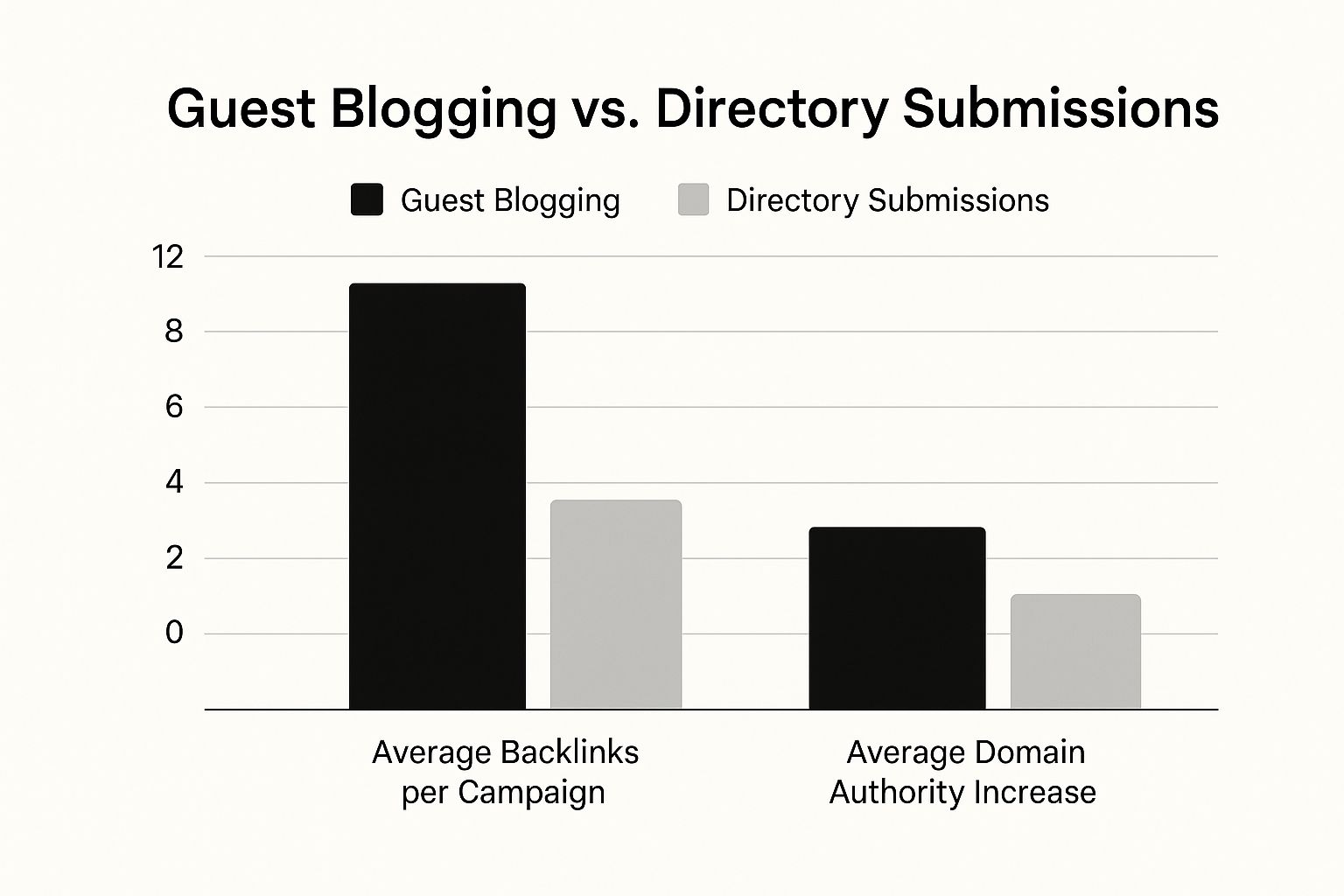If you want to grow your website traffic for the long haul, you have to get serious about organic. It all comes down to mastering three core areas: Search Engine Optimization (SEO) to get seen, high-quality content that actually solves problems, and building authority through trust signals like backlinks.
Nail these, and you'll create a sustainable flow of visitors who are already looking for exactly what you offer.
Why Organic Traffic Is Your Most Valuable Asset

Sure, paid ads can bring you visitors tomorrow. But that traffic disappears the second you turn off your credit card.
Organic traffic is different. It's the gift that keeps on giving. You're earning your audience's attention, not just renting it. That distinction is everything because it builds a foundation of trust and credibility that paid campaigns can rarely touch.
Think about it from a user's perspective. When someone finds you through a Google search, they see you as a relevant, authoritative answer to their question. That’s a much stronger starting point than an ad that just interrupted their feed.
The True Value of Earning Clicks
The data doesn't lie. Organic search is the undisputed king of website traffic. A staggering 94% of all clicks on Google go to organic results, leaving a tiny 6% for paid ads.
And the top spot is pure gold. On average, the first result on Google pulls in a 27.6% click-through rate. If you want to dig deeper, check out these organic vs. paid search statistics—you'll see how even a single-spot jump in rankings can dramatically boost your clicks.
It all points to one simple truth: people trust organic results more. Investing in the strategies that get you there isn't just a marketing expense; it's a direct investment in your brand's long-term health. You're building a digital asset that actually appreciates over time.
The goal isn't just more traffic; it's attracting the right traffic. Organic search is brilliant at this because it connects you with people who have a specific need or question, leading to higher engagement and, ultimately, better conversion rates.
The Pillars of Organic Traffic Growth
To help you get a clear picture of the road ahead, we've broken down the entire process into three core pillars. Each one is a critical piece of the puzzle, and they all work together to build unstoppable momentum for your site.
Here’s a quick overview of what we’ll be covering in this guide.
| Pillars of Organic Traffic Growth |
| :--- | :--- | :--- |
| Strategy Pillar | Primary Goal | Key Actions |
| On-Page & Technical SEO | Make it easy for search engines to find and understand your site. | Keyword research, meta tags, site speed fixes, and mobile optimization. |
| Content Marketing | Become the best answer to your audience's questions. | Blogging, creating pillar pages, building topic clusters, and publishing consistently. |
| Off-Page SEO & Authority | Build a trusted reputation across the web. | Earning high-quality backlinks, digital PR, and managing brand mentions. |
Throughout this guide, we’ll dive deep into each of these pillars. We're talking actionable steps and real-world examples to help you turn your website into a traffic-generating machine.
Refining Your On-Page SEO For Search Visibility
On-page SEO is where you stop guessing and start telling search engines exactly what your content is about. It’s the foundational work that makes sure your brilliant articles and valuable insights actually get found. Without it, even the best content gets lost in the digital noise.
Think of it this way: your website is a library, and on-page SEO is how you organize the shelves. A messy library is useless. A well-organized one, however, makes finding the right information effortless for both users and Google.
Master Your Keyword Research
Before you write a single word, you have to understand the language your audience uses. Keyword research isn't about stuffing your content with awkward phrases. It's about uncovering the real questions and pain points your ideal customers are typing into Google.
Your goal is to strike a balance between search volume (how many people are searching) and keyword difficulty (how hard it is to rank). Sure, a keyword with 50,000 monthly searches looks tempting, but if you're up against giants, you'll never make a dent. A more specific, long-tail keyword with 500 monthly searches is often pure gold because the user's intent is crystal clear and the competition is beatable.
- Go Beyond the Obvious: Instead of just "SaaS marketing," dig deeper. Think like your customer. They're searching for things like "how to get early users for SaaS" or "content strategy for B2B software." Those are the queries that lead to conversions.
- Spy on Your Competitors: Use SEO tools to see what keywords are sending traffic to your competitors. This is one of the fastest ways to find proven opportunities you might have missed.
- Listen to Real People: Your customer support tickets, sales calls, and community forums are keyword goldmines. They reveal the exact language your audience uses to describe their problems.
Crafting Titles and Descriptions That Earn Clicks
Your title tag and meta description are your first—and often only—chance to make an impression in the search results. They are a mini-advertisement for your page, and a great one can convince someone to click your link over a competitor's, even if you rank slightly lower.
Imagine someone searching for "how to increase website traffic organically." Which of these would you click?
- Blog Post About Organic Traffic
- 15 Actionable Ways to Increase Organic Traffic (Fast)
The second one wins, hands down. It's specific, promises a tangible benefit, and uses a number to stand out. It’s a value proposition, not just a title.
Your meta description needs to back up your title. Think of it like the back cover of a book—it should be just intriguing enough to make someone want to open the page and see what's inside.
For a deeper dive into structuring your content for both users and search engines, our guide on how to write an SEO-friendly blog post breaks it down step-by-step.
Structuring Content for Readability and Rankings
Once someone lands on your page, its structure determines whether they stick around. Google pays close attention to this, too, using your headings to understand the hierarchy and main topics of your content.
- H1 Tag: This is your page's main headline. You get one per page. Make it count, and make sure it clearly states what the page is about.
- H2 Tags: Use these to break up your content into major sections. They should be descriptive and are a great place to include secondary keywords naturally.
- H3 Tags: These are for sub-points within your H2 sections. They help organize your thoughts into smaller, digestible chunks.
Here’s a great visual example of how all these on-page elements come together to create a clear structure for both people and search engine crawlers.
As you can see, the title, URL, and headings all work together to signal relevance and create a much better user experience.
Optimizing Images for Search and Accessibility
Images are great for engagement, but they're also an overlooked SEO opportunity. Since search engines can't "see" what's in an image, they rely on the text you provide to understand its context.
The most important piece is the alt text. This is a short, descriptive phrase that explains what the image shows. Good alt text does two crucial jobs:
- Accessibility: It allows screen readers to describe the image to visually impaired users, making your site more inclusive.
- SEO: It gives search engines context, which can help your images rank in Google Images and adds to your page's overall topical relevance.
So, instead of a lazy alt text like "graph," write something descriptive like, "Bar graph showing a 35% increase in organic traffic from January to June." That small change makes a massive difference.
Developing Content That People Want to Read and Share

On-page SEO gets your site ready for search engines, but it's your content that actually wins over people. It’s the real engine behind any organic growth strategy. In a world drowning in information, just hitting "publish" isn't going to cut it. Your content has to be the absolute best answer to your audience's problems.
That means you have to move past thin, generic blog posts. The real goal is to create comprehensive resources that solve genuine problems, stamp your authority on a topic, and make people want to come back. You're aiming to be a destination, not just another pit stop on the SERP.
Building Authority with Pillar Pages and Topic Clusters
One of the most powerful ways to signal your expertise to Google is by organizing your content into a pillar page and topic cluster model. This isn't just about looking organized; it’s a strategic move that proves you have deep knowledge in a specific area, which is exactly what you need to rank for those highly competitive keywords.
Think of it like you're writing a book.
The pillar page is the book itself—a massive, long-form guide that covers a broad topic from A to Z. The topic clusters are your individual chapters—shorter, more focused blog posts that dive deep into specific sub-topics you touched on in the pillar page.
- Pillar Page Example: A monster guide called "The Ultimate Guide to B2B SaaS Content Marketing." It would cover everything from high-level strategy to the nitty-gritty of execution.
- Topic Cluster Examples: These are the deep dives, like "How to Create a SaaS Content Calendar," "Measuring Content ROI for B2B," and "7 Blog Post Formats That Actually Drive SaaS Demos."
Each cluster post links back up to the main pillar page, and the pillar page links out to all the cluster posts. This creates a tight web of internal links that screams "authority" to search engines. You're not just trying to rank for a single keyword; you're aiming to dominate an entire topic.
By building out topic clusters, you're not just writing articles; you're building an interconnected library of expertise. This structure makes it dead simple for users to find related information and for search engines to recognize the sheer depth of your knowledge.
Brainstorming Content That Actually Resonates
The best content ideas don’t come from a flash of genius. They come from a deep, almost obsessive, understanding of your audience’s pain points, questions, and goals. Your mission is to get inside their heads and create the exact resources they're already searching for. Forget what you think they want; find out what they actually need.
Start by digging into your existing customer data. Your sales and support teams are sitting on an absolute goldmine of content ideas. Seriously. They hear the same questions, objections, and frustrations day in and day out.
Here are a few places to find killer content ideas:
- Customer Support Tickets: What are the most common problems people run into? Turn those solutions into incredibly detailed tutorials or how-to guides.
- Sales Call Recordings: What are the biggest hesitations prospects have before they sign on the dotted line? Tackle these objections head-on in your content.
- Online Communities: Go hang out on Reddit or Quora. The questions people are asking in industry-related forums are literally the titles of your next blog posts.
A structured approach is everything. Our guide on building a content marketing strategy framework gives you a repeatable system for generating and validating ideas that tie directly back to what you're trying to achieve as a business.
The Power of a Consistent Publishing Cadence
Creating one amazing piece of content is great, but publishing consistently is what builds real momentum and keeps you relevant in the eyes of search engines. A regular publishing schedule signals to Google that your site is alive and kicking, which can give your rankings a nice boost.
More importantly, it builds a loyal audience. When people know they can expect valuable new stuff from you every week, they have a reason to come back. That consistency builds trust and turns one-time visitors into dedicated followers.
The data backs this up, big time. Companies that publish 16 or more blog posts per month can get 3.5 times more website visits than those publishing four or fewer. The correlation between content frequency and organic traffic is crystal clear. Plus, with over 70% of internet users saying they'd rather learn about a company from a blog than an ad, a steady stream of quality content is a no-brainer.
Now, consistency doesn't mean you should start churning out garbage just to hit a quota. It's about creating a realistic publishing calendar and actually sticking to it. Whether that’s one high-quality post a week or four, the key is to set a pace you can maintain for the long haul. This discipline is fundamental if you're serious about growing your organic traffic.
Earning Authority with Modern Off-Page SEO
Once your on-page SEO is solid and your content is genuinely helpful, it's time to shift your focus outward. This is where off-page SEO comes in—it's all about building your website's reputation across the web.
Think of it as building a professional network. A strong recommendation from an industry leader carries way more weight than a hundred anonymous endorsements. In the same way, a single, high-quality backlink from a respected site tells Google that your content is trustworthy and authoritative.
This isn’t about tricking algorithms with spammy tactics that worked a decade ago. It's about earning genuine signals of trust that prove your site is a valuable resource. Modern off-page SEO is basically digital public relations, and it's a critical piece of the puzzle for anyone serious about increasing organic website traffic.
The Power of High-Quality Backlinks
Backlinks—hyperlinks from another website to yours—are a primary signal of authority for search engines. But here's the catch: not all backlinks are created equal. The days of buying thousands of cheap, low-quality links are long gone. Today, that’s just a fast track to a Google penalty.
The goal is quality over quantity.
One link from a major industry publication is worth more than a thousand links from irrelevant, low-authority blogs. Search engines see these high-quality links as votes of confidence, which directly boosts your site's ability to rank higher.
This image really drives the point home, showing the massive difference in impact between a modern tactic like guest blogging versus an outdated one like directory submissions.

The data is clear: value-driven strategies like guest blogging deliver far superior results in both the number of links and the authority they pass.
Strategic Guest Posting for Authority and Traffic
Guest posting is one of the most reliable ways to earn high-quality backlinks. It’s pretty straightforward: you write and publish an article on another website in your industry. It's a win-win—the host site gets great, free content, and you get exposure to a new audience and a valuable backlink.
But to do it right, you have to be strategic.
- Find Relevant Opportunities: Don't just pitch anyone with a blog. Look for sites that share your target audience and have strong domain authority. A post on a respected industry blog is a powerful signal.
- Pitch a Valuable Idea: Generic emails get deleted. Do your homework—study the blog, understand its audience, and pitch a specific article idea that fills a genuine gap in their content.
- Write Your Best Stuff: This isn't the time to phone it in. Your guest post is a direct reflection of your brand, so deliver an incredibly helpful, well-written article that makes them proud to publish it.
A great guest post does more than just secure a backlink. It positions you as an expert, drives referral traffic from an engaged new audience, and builds relationships with other key players in your industry.
Leveraging Digital PR and Brand Mentions
Beyond just building links, your overall online reputation is a huge factor. Digital PR is all about getting your brand mentioned on reputable platforms like news sites, podcasts, and industry publications.
Even when these mentions don't include a hyperlink—known as unlinked brand mentions—they still send positive signals. Google is smart enough to associate these mentions with your brand, which helps build your site's overall authority and trust.
A fantastic way to generate these mentions is by creating unique, data-driven content. Think original research, industry surveys, or insightful reports. This kind of content is highly shareable and often gets picked up by journalists and bloggers looking for credible sources to cite.
Effective Link Building Strategies Comparison
To win at off-page SEO, you need a mix of strategies. Here’s a quick comparison of some modern techniques, highlighting their effort level and potential impact.
While some methods are quicker wins, a balanced approach combining high-impact strategies like guest posting and digital PR with other tactics will yield the best long-term results.
Building Your Social Signals
While social media shares aren't a direct ranking factor like backlinks, they play a crucial supporting role. An active social media presence gets your content in front of more people, which increases the odds that someone with a high-authority website will see it, love it, and link to it.
Sharing your content on platforms like LinkedIn, X (formerly Twitter), and even Reddit can kickstart the sharing cycle. The more eyeballs on your content, the greater the opportunity for it to earn natural backlinks and brand mentions. Our guide on B2B social media marketing strategies offers actionable tips for using these platforms to amplify your content's reach.
Ultimately, a modern off-page strategy is about creating value beyond the confines of your own website. By contributing to your industry's conversation, you build a powerful web of authority that search engines simply can't ignore.
Laying a Flawless Technical SEO Foundation

You can create the most brilliant content and earn the best backlinks on the web, but none of it matters if search engines can't properly access, crawl, and understand your website. Technical SEO is the bedrock of your entire organic strategy. It's all about making sure your site’s architecture is clean, fast, and dead simple for search engine bots to navigate.
Ignoring the technical side is like building a skyscraper on a shaky foundation—it’s only a matter of time before things start to crumble. A rock-solid technical setup ensures that all your other efforts can deliver maximum impact without being held back by hidden issues.
Prioritize Lightning-Fast Site Speed
Page speed isn't just a minor ranking factor anymore; it's a fundamental part of the user experience. We live in an age of instant gratification, and every millisecond counts. A slow-loading site doesn't just frustrate visitors—it sends a massive negative signal to Google, which prioritizes sites that provide a smooth, fast experience.
Think about your own browsing habits. If a page takes more than a few seconds to load, you’re probably hitting the "back" button. Google knows this, which is why its Core Web Vitals are now a critical part of its ranking algorithm. These metrics are a direct measure of your site's loading performance, interactivity, and visual stability.
To get your site speed up to par, focus on these wins:
- Image Compression: Large, unoptimized images are one of the biggest speed killers. Use tools to compress them without sacrificing noticeable quality.
- Browser Caching: This lets repeat visitors load your site much faster by storing static files (like your logo and CSS) in their browser's cache.
- Minify Your Code: Clean up unnecessary characters from your HTML, CSS, and JavaScript. It reduces the amount of data that needs to be loaded and can make a real difference.
Adopt a Mobile-First Mindset
The way people search has fundamentally changed. The desktop is no longer king. Google now operates on a mobile-first indexing model, meaning it primarily uses the mobile version of your site for indexing and ranking. If your site isn't a dream to use on a phone, you're fighting a losing battle.
This is completely non-negotiable. Mobile organic searches surpassed 50% in the U.S. years ago, so a seamless mobile experience is essential for capturing the majority of your potential audience. This also ties into content; the average first-page result is over 1,400 words, and your site must deliver that in-depth content effectively on a small screen. You can find more data on these digital search trends if you're curious.
A mobile-friendly design is more than just shrinking everything down. It requires a thoughtful approach to navigation, button sizes, and readability to ensure users can easily find what they need without getting frustrated.
A poor mobile experience is one of the fastest ways to lose a potential customer. If users have to pinch and zoom just to read your text, they won't stick around. Your bounce rate will spike, telling Google that your page isn't a good result.
Demystify Structured Data and Schema Markup
Structured data, usually implemented with schema markup, is a powerful way to help search engines understand the context of your content. Think of it as adding descriptive labels to your information so that Google can read and interpret it more effectively.
For instance, you can use schema to tell Google that a set of numbers is a product rating, a string of text is an event date, or a page is a recipe with specific ingredients and cooking times.
Why bother? Because this extra context can help you earn rich snippets in the search results. These are the enhanced listings you see with star ratings, review counts, or FAQ dropdowns right on the search page. Rich snippets make your listing pop, which can seriously improve your click-through rate.
Maintain a Clean URL Structure
Finally, don't overlook your URLs. A clean and logical URL structure is crucial for both users and search engines. Your URLs should be simple, descriptive, and easy to read. A well-structured URL gives crawlers a clear path to follow and helps users understand exactly where they are on your site.
Just look at these two examples:
- Bad URL:
www.example.com/p?id=123&cat=456 - Good URL:
www.example.com/blog/technical-seo-guide
The second URL is immediately understandable. It contains relevant keywords and clearly communicates the page's content, making it far more effective for both SEO and user experience. Keeping your URLs clean and consistent is a simple but vital part of a solid technical foundation.
Common Questions About Organic Traffic Growth
Even with the best strategy in hand, questions are going to pop up. It's only natural. Getting organic growth right means understanding the timelines, knowing what to tackle first, and figuring out what actually moves the needle.
Let's clear the air and dive into the practical realities of what it takes to win. These are some of the most common questions we get asked all the time.
How Long Does SEO Take to Show Results?
This is the big one, isn't it? Everyone wants to know when the magic happens. While you might spot small ranking improvements in a few weeks, real, significant organic traffic growth is a long game.
Being realistic, you should expect to see meaningful results in 4 to 6 months. SEO isn't a switch you flip; it's more like a flywheel you have to get spinning. Your industry’s competitiveness, your starting domain authority, and your consistency all play a huge role. Patience is everything.
I see this all the time: a company gives up after two months because the traffic needle hasn't shot up. That's a huge mistake. The compounding effects of consistent, high-quality SEO work often kick in right around the six-month mark. Trust the process.
Quality or Quantity for Content Marketing?
It's the classic debate, but the answer is crystal clear: quality always wins.
Think about it. One comprehensive, deeply researched article that genuinely solves a reader's problem will do more for your authority and traffic than ten short, superficial posts ever could. Google's job is to find the best answer, not the most answers.
The sweet spot, of course, is a consistent quantity of high-quality content. A regular publishing schedule signals to search engines that you're fresh and relevant. The key is to find a cadence you can actually maintain without ever letting the value of your posts slip.
Prioritizing Your SEO Efforts
When you're starting out, it's easy to get overwhelmed. Link building? Site speed? Content? Where do you even begin? My advice is always the same: start with the foundation.
- Technical and On-Page SEO First: Your website is the home for all your content. Make sure it's a solid one. It needs to be fast, mobile-friendly, and properly structured around your main keywords.
- Content Creation Next: Once the house is in order, you can start filling it with high-value content that attracts and engages your ideal audience.
- Off-Page SEO Last: With a great site and fantastic content already in place, your link-building and promotional efforts become a thousand times more effective.
It's just common sense. You fix your house before you start inviting guests over. Do that, and your off-page SEO efforts will pay off big time.
The organic search world is also being reshaped by AI. As of 2025, while the top five results still get about 70% of clicks, long-tail keywords now drive a massive 69% of all search traffic. But some analysts are predicting a major drop in organic traffic by 2028 due to AI-powered "zero-click" searches. This makes building a strong brand and creating experience-led content more critical than ever. You can read the full research on the future of organic search on theedigital.com.
At PimpMySaaS, we specialize in building that brand authority for B2B SaaS companies. We do it by creating and dominating conversations on platforms like Reddit, making sure you're seen as the definitive answer when people ask questions. Find out how we get your brand mentioned in AI-powered searches at https://www.pimpmysaas.com.
